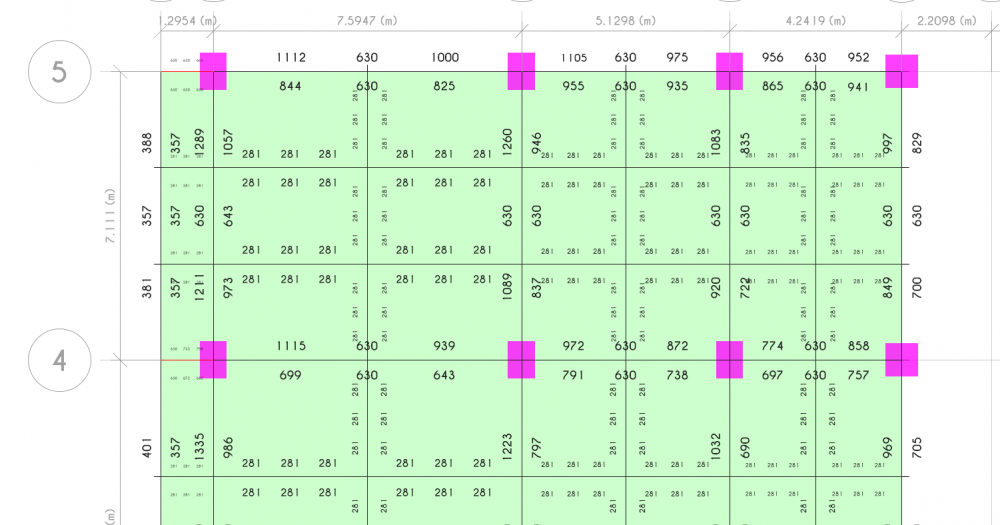Search the Community
Showing results for tags 'concrete'.
-
The cantilever beams fails in shear even if the size is increased. Can torsional modifier of 0.001 be applied on these beams considering the case of compatibility torsion? or is this the case of equilibrium torsion?
-
Hey Guys I am a civil engineer by profession. I am working with a construction firm specializing in apartments and pensions design and building. However, now that I am much more experienced in my field, I will start my own work. Now I have started a small house construction project, and I am here to discuss the foundation design of that house. The foundation design is quite an important part of the construction as it ensures structure stability, safety, and support. It is difficult to measure the load-bearing capacity of soil in a small area like a house; however, we can ensure that our house's foundation is strong enough to hold its weight. We can begin by selecting the house's location with good soil quality and a stable foundation. Concrete slabs are often preferred for creating a house's foundation. This is because they provide more strength and stability than other foundations like blocks or timber frames. Moreover, it is important to use high-quality materials for the foundation, such as steel reinforcements, cement, and aggregates. The placement of the foundation should also be considered carefully. It should be placed below the frost line to ensure that it is not affected by frost heaves and other weather conditions. However, as a first-time solo builder, I am here to ask some questions from experts. What foundation is most suitable for a house close to the sea? What type of insulation should be used to provide additional protection against moisture and water seepage? How should the foundation be anchored correctly to ensure it is not affected by wind or other external forces? How should reinforcements, cement, and aggregates be used to ensure the foundation is durable? Where can I find coupons and discounts on the materials needed for the foundation? I'm looking forward to hearing your advice. Thank you in advance!
-
Abstract This research project is aimed at analyzing the mortar of the historical Ramkot Fort in Azad Jammu and Kashmir (AJK), Pakistan and designing a modern day compatible mortar for its restoration. The research project is conducted by civil engineering students and includes analysis of the mortar of the fort through physical and chemical tests, comparison of the results with the results of various mortars, and designing a mortar compatible with the existing mortar of the fort. The physical tests include the sieve test, water absorption test and compressive strength test, while the chemical tests include the X-ray fluorescence test, X-ray diffraction test, and the Scanning Electron Microscope-Energy Dispersive Spectroscopy test. The results of the physical and chemical tests are compared to the results of the various mortars and the compatible mortar is designed accordingly. Introduction Ramkot Fort is a historical fort located in Azad Jammu and Kashmir (AJK), Pakistan. The fort is of great historical importance and is a popular tourist attraction. The fort is in need of restoration and preservation due to its age. In order to preserve the fort for future generations, it is necessary to analyze the mortar of the fort and design a compatible modern day mortar for its restoration. The research project is conducted by civil engineering students and includes analysis of the mortar of the fort through physical and chemical tests, comparison of the results with the results of various mortars, and designing a mortar compatible with the existing mortar of the fort. Methods The mortar of the fort is analyzed through various physical and chemical tests. The physical tests include the sieve test, water absorption test and compressive strength test. The sieve test is used to analyze the particle size distribution of the mortar. The water absorption test is used to measure the porosity of the mortar. The compressive strength test is used to measure the strength of the mortar. The chemical tests include the X-ray fluorescence test, X-ray diffraction test, and the Scanning Electron Microscope-Energy Dispersive Spectroscopy test. These tests are used to analyze the composition of the mortar. Results The results of the physical tests show that the mortar of the fort has a particle size distribution of 0.5 to 4.5 mm, a porosity of 17.8%, and a compressive strength of 19.2 MPa. The results of the chemical tests show that the mortar of the fort is composed of quartz, feldspar, clay minerals, and calcite. Comparison The results of the physical and chemical tests are compared to the results of the various mortars and the compatible mortar is designed accordingly. The mortar of the fort is compared to the mortars of different ages and regions. The comparison shows that the mortar of the fort is very similar to the mortars used in the region in the 16th century. Conclusion The research project has successfully analyzed the mortar of the historical Ramkot Fort in Ajk, Pakistan and designed a modern day compatible mortar for its restoration. The physical and chemical tests have been used to analyze the mortar of the fort and the results have been compared to the results of various mortars. The compatible mortar has been designed accordingly. Comments The research project has successfully analyzed the mortar of the historical Ramkot Fort in AJK, Pakistan and designed a modern day compatible mortar for its restoration. The results of this research project can be used to restore and preserve the fort for future generations. References 1. National Monuments of Pakistan, Ramkot Fort https://pakistanmonuments.com/ramkot-fort/ 2. Ali, M., Tahir, M. N., & Iqbal, M. (2016). Characterization of ancient mortars in the fort of Mughal period. Construction and Building Materials, 112, 902-911. 3. Khan, H., & Khan, A. (2016). Characterization and Testing of Mortars Used in Historical Buildings of Pakistan. Journal of The Institute of Engineers Pakistan, 67(4), 29-40. 4. Khan, M. A., & Khan, N. (2018). Physical and Chemical Analysis of Ancient Mortar of the Monuments of Pakistan. Asian Journal of Civil Engineering (Building and Housing), 19(6), 763-781.
-
Societies and buildings are growing like weed, no control over anything, no construction standards, no development standards, no QA/QC, no sustainability under consideration, not a single thought to future of these buildings, just a person announces a building and start selling alongside road, gather public funds and becomes a builder.No thought to site selection, no traffic study, there are 20 storey apartment alongside a 30ft wide rd, there are buildings in the way of river and we are flood prone nation, where are Govt Dept, NDMA, PDMA,(might be waiting to happen something) who is allowing societies to sell river beds or pathways.Sustainable future is necessity for next generation, but our town planners are creating plots in every corner of land, there is not a single society that is harvesting rain water, rain water is drained out and Ground water table is lowering day by day in city areas, we consider it for granted but it is not so, we need to recharge ground water, there are simple techniques that can recharge ground water table.Maintenance of concrete buildings is an issue, there are no post construction inspections, no safety precautions against fire, no proper design of firefighting. Mass concrete production is contributing to climate change and consumption of natural materials unwisely. Buildings shall be inspected after every 5 years for structural integrity for the safety and security of public.Ready Mix concrete supplier are producing third class concrete, no check and balance on them and builders just consider cheapest one, no design mix consideration.Engineers are not doing there part to develop designs and Architects are trying to produce something extra ordinary without thinking of construction strategies, they want to make a sellable product, not a livable, sustainable space for living.Commercialization of professions is killing the nature, society, values, sustainability, standards and ethics.We need to stop and think as a Nation!!! We can do much better.
-
- buildings
- construction
-
(and 6 more)
Tagged with:
-
Dear all, I'm designing a retaining wall with 22 ft height of stem and angle of internal friction as 30 deg. I thought of doing it in RCC but somebody told me that retaining walls have been casted in PCC with much more heights i-e above 50ft. Can anyone guide me on this as PCC is a much more cost effective approach as compared to RCC. Thanks.
- 3 replies
-
- concrete wall
- concrete
-
(and 1 more)
Tagged with:
-
Salaam, Hi to all and everyone. we are Hubcrete Pvt. Ltd. and we using this platform to learn and improve our products and services. We know that together we can build better cities, nation and country. Regards Hasnain Sharif Hubcrete Pvt. Ltd.
-
Assalamualaikum SE pakistan in general placement of rebar, i always see that the rebars set on the same spacing. These are 2 columns they have the same ratio of reinforcement, same dimentions, but the placement of rebar about 2 axis the A one has larger d than the B one and according to calculation its obvious that the A one gives the larger moment resistance(M3) , which one give the best overall resistance i mean not only the moment resistance but to overall ? the A one or B one? Regards
- 3 replies
-
- moment
- reinforced
-
(and 2 more)
Tagged with:
-
Concrete on the building exterior treated to an exterior finish e.g. paint is classified as concrete exposed to weather or not? I am facing this problem in placing the reinforcement, the exterior will be painted and weather protected, should I follow the cover requirements of concrete exposed to weather or not?
- 1 reply
-
- aci
- reinforcement
-
(and 1 more)
Tagged with:
-
I have modeled a simple 6m long concrete circular column of 760mm diameter. I have applied a joint live load at the top of the column. Selecting ACI-318 as design code with frame type as sway special, I get the flexural and shear reinforcement. However, when I change the design code to AASHTO Concrete 2007 in the design preferences with zone 3 in overwrites, I get nearly same flexural reinforcement as by ACI but I observe a huge difference in shear reinforcement. It is to be noted that I have used same combination while designing by both codes. Please check the file attached and explain. G.SDB
-
We are looking for some reference for placement of concrete in tunnel. What is the maximum horizontal length of placement of concrete and at what interval we can place the next adjacent pour of concrete.? Is there any code limitation on this or we can go to the next pour placement.?
- 8 replies
-
- joints
- underground
-
(and 3 more)
Tagged with:
-
http://www.bbc.com/news/magazine-34667034
-
If concrete fc'=17.82 MPa, is there any relation from which I can find its fracture energy? I have seen CEB-FIP codes, they give the fracture energy with respect to aggregate sizes. I dont have aggregate size for my concrete. Now when I am doing finite element modelling, so I require fracture energy. Is there any approx. values of fracture energy with respect to concrete strength? Thank you
-
Any One here familiar with about how to use fullers curve in packing of aggregates?
-
Assalam O Alaikum Respected Members, Hope you all are doing good. Does anyone here know what is the procedure of bridge design. Or can anyone link me to any tutorial from where i can get guidance. I have a very basic understanding that too of the grillage design but want to know more about bridge design. Thanks.
-
salam i have problem related to defining concrete material i have attached the image. its shown there that mass per unit volume of concrete is 2.24 and weight per unit volume of concrete is 8.68 while the units are kip-in. and fc'=4ksi. i want to know how both these value comes?? and if fc'=3ksi then what will be the values of these two?? i-e mass per unit volum nd weight per unit volume???










